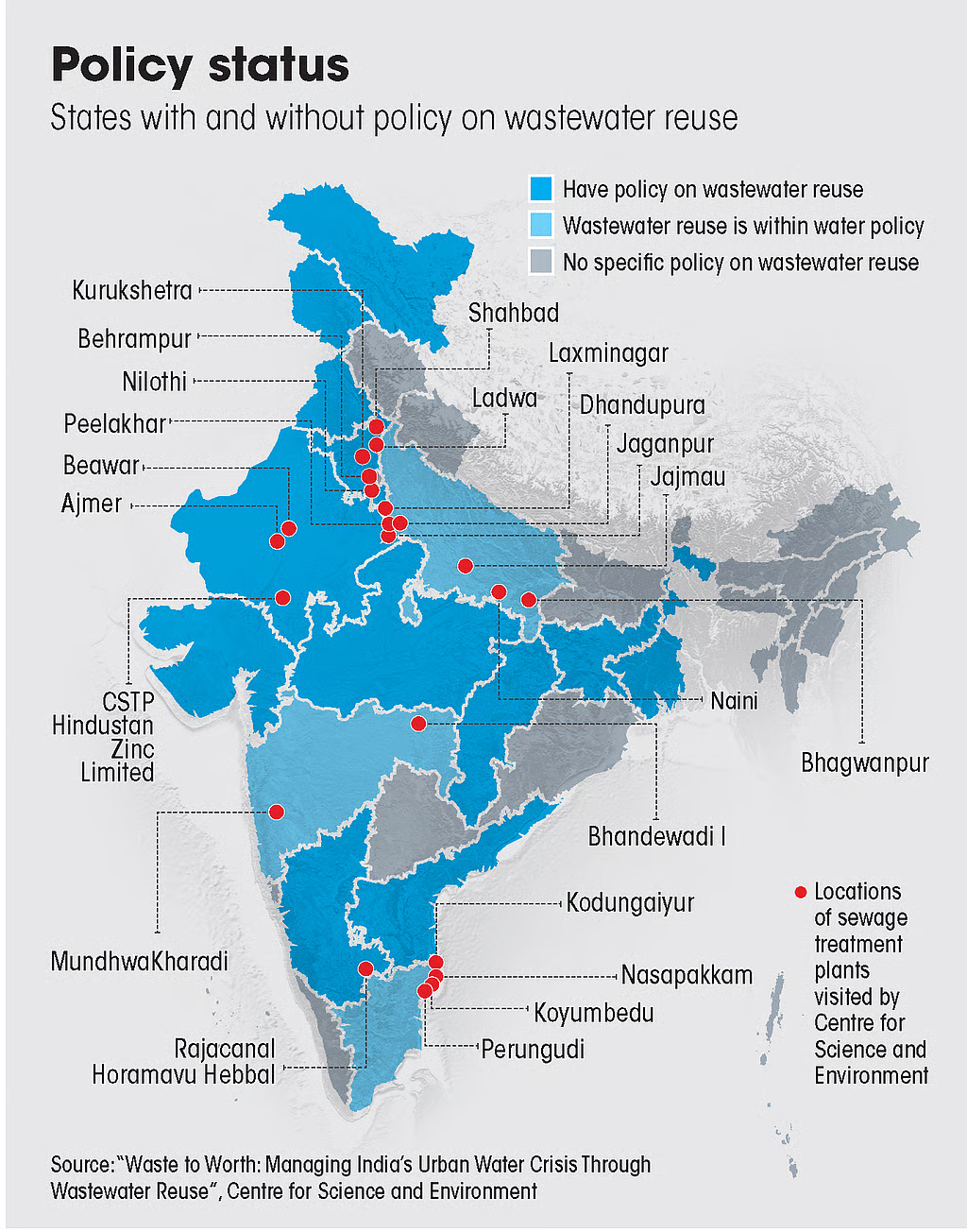Font size:
Print
India’s Growing Water Crisis
Resolving food challenge without fixing water uses
Context: Water is the foundation of human development — essential for food security, public health, energy generation, and sanitation. But india is currently facing a huge on-going Water Crisis.

More on News
- Yet across the globe, and particularly in India, water demand is rapidly outpacing supply.
- As urbanisation accelerates and industrial growth expands, agriculture continues to dominate water consumption.
- With only 4% of the world’s freshwater and nearly 18% of its population, India is facing an escalating water crisis.
Agriculture’s Water Footprint in India
- India is a global agricultural powerhouse — the largest producer of milk and spices and the second-largest producer of fruits, vegetables, and fish.
- However, over 80% of India’s freshwater withdrawals are consumed by agriculture, much of it inefficiently.
- According to various studies, between 78% to 90% of India’s total water use goes into farming.
- This overdependence on groundwater is pushing several regions toward depletion.
- In Punjab, for example, groundwater levels are dropping by more than a metre annually, driven by intensive paddy cultivation and free electricity for irrigation.
- Alarmingly, 78% of Punjab’s administrative blocks are now classified as “over-exploited,” up from 50% in 2004.
A Broken Model: Water-Wasting Crops, Poor Nutrition
-
- The Green Revolution enabled food self-sufficiency, but at the cost of sustainability and nutrition.
- Government incentives, including minimum support prices (MSPs) and irrigation subsidies, continue to favour water-intensive, calorie-dense crops like rice and wheat.
- The result: poor nutritional outcomes despite a surplus of food grains.
-
- Data from NFHS-5 shows that 35.5% of children under five in India are stunted, 32.1% are underweight, and 16.6% of the population is undernourished.
Reimagining Irrigation: A Key to Sustainable Agriculture
- Irrigation, often blamed for groundwater depletion, can become a powerful tool for transformation.
- Smart irrigation practices not only improve crop yields but also enable a shift towards growing pulses, vegetables, and oilseeds — crops that are more nutritious and water-efficient.
- These crops can boost rural incomes, provide livestock fodder, reduce migration, and increase dietary diversity.
Policy Disconnect
- India’s water-agriculture crisis stems from policy choices made decades ago.
- In Punjab, free electricity and paddy procurement replaced traditional cropping patterns.
- In Maharashtra, sugarcane occupies just 4% of the state’s agricultural land but uses more than 70% of its irrigation water — especially disastrous in drought-hit districts like Solapur.
- However, Gujarat’s Jyotigram Yojana offers a model for reform.
- By separating domestic and agricultural power feeders and metering irrigation supply, groundwater extraction was reduced by 20%, and micro-irrigation systems expanded in arid regions like Saurashtra and Kutch.
Two-Pronged Strategy for Water Reform
To address the crisis, India must adopt a dual approach: boost water availability in underutilised regions such as eastern India and curb excessive water use in overdrawn zones like the northwest.
-
Align MSPs with Sustainability and Nutrition: Agro-ecological crop planning is essential.
- Minimum support prices should promote climate-resilient crops like millets, pulses, and oilseeds in rainfed areas.
- The UN’s declaration of 2023 as the International Year of Millets was a step forward, but India needs sustained fiscal backing, procurement mechanisms, and consumer campaigns to make nutritious crops viable for farmers.
-
Rationalise Water and Electricity Pricing: Free or heavily subsidised electricity has led to unchecked groundwater use.
- Pilot programs, such as prepaid smart meters in Andhra Pradesh, have shown promise — cutting power use by 15% and encouraging adoption of water-saving technologies like drip irrigation.
- Transparent, efficient pricing mechanisms can drive behavioural change without punitive measures.
-
Scale Up Micro-Irrigation Systems: Despite having 74 million hectares under irrigation, only 12% of Indian farmland uses drip or sprinkler systems.
- These technologies can save 30% to 70% of water depending on the crop.
- Scaling them up requires public-private partnerships, equipment leasing, targeted subsidies, and awareness campaigns, especially for smallholder farmers.
-
Invest in Water Literacy and Farmer-Led Management: Technical reforms will fail without a change in how farmers perceive water.
- Many equate excessive water use with higher productivity, unaware of the long-term risks.
- Initiatives like water user associations, participatory irrigation management, and groundwater mapping (as in Maharashtra’s Jalyukta Shivar Abhiyan) can build awareness, ownership, and accountability at the grassroots level.
From Political Arithmetic to Hydrological Logic
- India’s agricultural success cannot come at the cost of ecological collapse.
- Water must be treated not as an unlimited political entitlement, but as a finite and valuable economic resource.
- That means rethinking outdated subsidies, realigning procurement policies, pricing water and energy wisely, and supporting farmers with the tools and knowledge to adapt.
Subscribe to our Youtube Channel for more Valuable Content – TheStudyias
Download the App to Subscribe to our Courses – Thestudyias
The Source’s Authority and Ownership of the Article is Claimed By THE STUDY IAS BY MANIKANT SINGH




